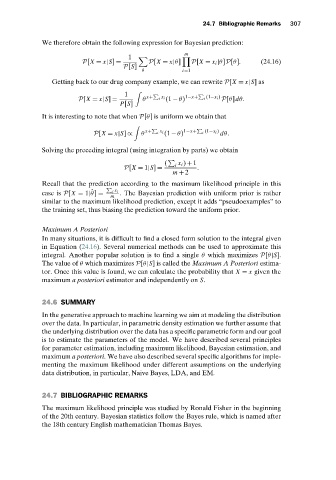Page 325 - Understanding Machine Learning
P. 325
24.7 Bibliographic Remarks 307
We therefore obtain the following expression for Bayesian prediction:
m
1
P[X = x|S] = P[X = x|θ] P[X = x i |θ]P[θ]. (24.16)
P[S]
θ i=1
Getting back to our drug company example, we can rewrite P[X = x|S]as
1 F x (1−x i )
P[X = x|S] = θ x+ i i (1 − θ) 1−x+ i P[θ]dθ.
P[S]
It is interesting to note that when P[θ] is uniform we obtain that
F
x (1−x i )
P[X = x|S] ∝ θ x+ i i (1 − θ) 1−x+ i dθ.
Solving the preceding integral (using integration by parts) we obtain
( i x i ) + 1
P[X = 1|S] = .
m + 2
Recall that the prediction according to the maximum likelihood principle in this
x
i i
case is P[X = 1| ˆ θ] = . The Bayesian prediction with uniform prior is rather
m
similar to the maximum likelihood prediction, except it adds “pseudoexamples” to
the training set, thus biasing the prediction toward the uniform prior.
Maximum A Posteriori
In many situations, it is difficult to find a closed form solution to the integral given
in Equation (24.16). Several numerical methods can be used to approximate this
integral. Another popular solution is to find a single θ which maximizes P[θ|S].
The value of θ which maximizes P[θ|S] is called the Maximum A Posteriori estima-
tor. Once this value is found, we can calculate the probability that X = x given the
maximum a posteriori estimator and independently on S.
24.6 SUMMARY
In the generative approach to machine learning we aim at modeling the distribution
over the data. In particular, in parametric density estimation we further assume that
the underlying distribution over the data has a specific parametric form and our goal
is to estimate the parameters of the model. We have described several principles
for parameter estimation, including maximum likelihood, Bayesian estimation, and
maximum a posteriori. We have also described several specific algorithms for imple-
menting the maximum likelihood under different assumptions on the underlying
data distribution, in particular, Naive Bayes, LDA, and EM.
24.7 BIBLIOGRAPHIC REMARKS
The maximum likelihood principle was studied by Ronald Fisher in the beginning
of the 20th century. Bayesian statistics follow the Bayes rule, which is named after
the 18th century English mathematician Thomas Bayes.

